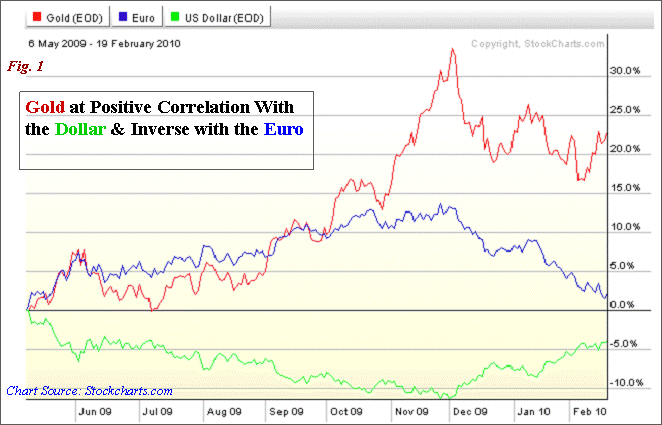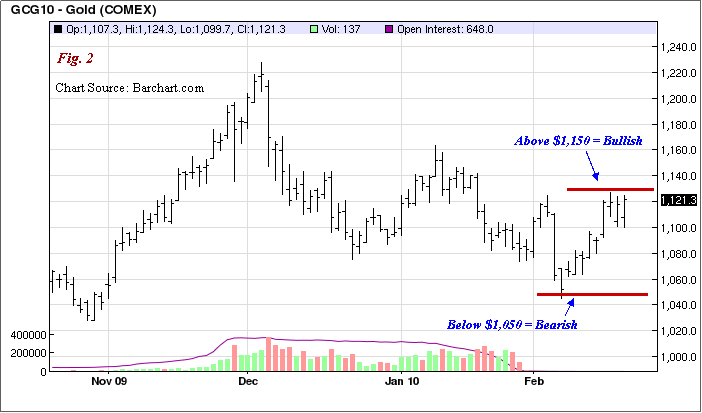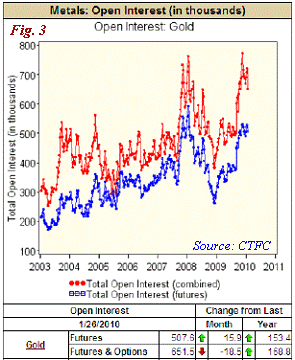Gold and Euro, A New Tango For 2010
Commodities / Gold and Silver 2010 Feb 21, 2010 - 08:49 PM GMTBy: Dian_L_Chu
 The U.S. dollar rose, commodity prices dropped and stocks fell last Friday after the Federal Reserve unexpectedly lifted an emergency lending rate for the first time since the financial crisis.
The U.S. dollar rose, commodity prices dropped and stocks fell last Friday after the Federal Reserve unexpectedly lifted an emergency lending rate for the first time since the financial crisis.
The dollar hit an eight-month high against a currency basket, while gold prices rose as investors bought the metal to hedge against paper currencies and debt default risks in Europe. Gold futures ended on Friday with a weekly gain of 3.1% at $1,122.10 an ounce.
Gold’s Retreat
Gold had rallied to a record of $1,218.30 an ounce on Dec. 3, 2009, as near-zero U.S. interest rates and government spending weighed on the dollar and countries including India and China boosted gold reserves.
However, bullion in the spot market has declined more than 6% since December, as the U.S. dollar benefited from the unfolding debt crisis in Dubai, Greece and the rest of southern Europe.
New Inverse Tango with Euro
Since gold is primarily a hedge against the dollar and inflation, it typically has the strongest inverse correlation with the US dollar. In the last month, however, the trend has broken with gold trending inversely with the euro and positively with the dollar (Fig. 1). The euro has now taken center stage in dictating the price of gold as it pertains to the fiscal health of Greece and other eurozone countries.

Fears over the outlook for the euro have been driving investors out that currency, and lifted both bullion and the dollar as alternative assets. The euro has declined, particularly against the dollar and gold, almost 5% against the dollar, and gold in euro terms is up 4.2%, so far in 2010.
Mariachi - PIIGS & The Fed
The new trend between the euro, dollar and gold is expected to continue amid fiscal challenges in the UK and Eurozone, PIIGS (Portugal, Iceland, Italy, Greece and Spain) in particular. Uncertainty over the details of any financial rescue package for Greece will likely keep the mood in the markets nervous, and the currency markets volatile in the near term.
In addition, the Fed's discount rate hike signals that other central banks will likely follow suit in exiting from stimulus measures, while the eurozone, UK and Japan will likely lag behind. This view has partly triggered selling of the euro against the dollar, and some other currencies to seek a positive yield and perceived safety.
These two factors will likely continue to be the major forces driving the euro’s direction for the rest of Q1, and may spill over into Q2 depending upon solutions to the Eurpoean Union`s debt problems and dearth of future growth opportunities.
Technicals - Short-term Mixed
Technically speaking, the short term indicators of gold are mixed and still trending bearish as gold prices remains in the lower part of its recent trading range.
Technical analysts have widely diverging views as well. For instance, Chartered Market projects gold to reach about $1,400 within 12 months as long as the $1,000 level holds; whereas Barclays Capital considers a “fair value” for gold around the $700 to $800 an ounce level.
Meanwhile, Nouriel Roubini, economics professor at the Stern School of Business, New York University, says that there is a bubble in commodities, and that the price of gold should be no higher than $1,000 an ounce given the current market conditions.

Techincal levels of significance would be a breakout above the $1150 level, which would be bullish; and breakout below the $1050 level of support, which would be bearish for the commodity. (Fig. 2)
Vulnerable to Rapid Unwind
According to the Commodity Futures Trading Commission (CFTC), NYMEX gold futures open interest increased 3.2% in January. Commercial traders increased their long positions, while holding net short positions. Non-commercial speculators held net long positions but increased their short positions. Overall, about 54% of the participants held net long positions in January. (Fig. 3)

Gold has attractions for those managers of private institutional funds. Many investors from George Soros to John Paulson have been buying gold as lower interest rates and continued money-printing could devalue the U.S. dollar in the long term.
Billionaire fund manager George Soros, for instance, told the financial elite at Davos that gold represented the "ultimate asset bubble”; however, data from SEC filing showed his fund more than doubled the stake in the SPDR Gold Trust (GLD) three months earlier. In fact, the gold trust is now his fund's biggest investment, valued at $663 million.
The large number of long speculators playing in the Gold market could leave the market vulnerable to a rapid unwinding when sentiment changes – the crowded trade scenario. One can only speculate that Mr. Soros could be seeking to exploit this market vulnerability with his seemingly uncharacteristic and contradictory actions.
Other Market Factors
Furthermore, the gold price direction also hinges on several events about to unfold within the next few months:
1) Greece's borrowing needs are covered only until mid-March, and is set to launch a new bond offering of $7 billion in coming days – Eurozone/euro could stand or fall on the success or failure of this bond sale.
2) European finance ministers gave Greece a one-month reprieve to show its deficit reduction plan was being rolled out effectively.
3) Dubai World will present a proposal to creditors in March to restructure about $22 billion of debt.
4) The IMF’s phased open-market sales of the remaining 191.3 tons of gold it planned to sell last year as there are no more official buyers – Bearish for gold, unless another central bank steps up.
5) The Federal Reserve will end a $1.25 trillion program of mortgage-debt purchases in March – Gold-bearish as it reduces liquidity.
As ever gold thrives on financial, economic and monetary uncertainty, there is certainly plenty of that in the world today. Sovereign risk will likely remain the main theme for 2010, and possibly 2011. This all sets the stage for the next five years of monetary and fiscal policy decisions around the globe which will ultimately define the future for this precious metal from an investment standpoint.
Disclosure: No Positions
Dian L. Chu, M.B.A., C.P.M. and Chartered Economist, is a market analyst and financial writer regularly contributing to Seeking Alpha, Zero Hedge, and other major investment websites. Ms. Chu has been syndicated to Reuters, USA Today, NPR, and BusinessWeek. She blogs at Economic Forecasts & Opinions.
© 2010 Copyright Dian L. Chu - All Rights Reserved Disclaimer: The above is a matter of opinion provided for general information purposes only and is not intended as investment advice. Information and analysis above are derived from sources and utilising methods believed to be reliable, but we cannot accept responsibility for any losses you may incur as a result of this analysis. Individuals should consult with their personal financial advisors.
© 2005-2022 http://www.MarketOracle.co.uk - The Market Oracle is a FREE Daily Financial Markets Analysis & Forecasting online publication.



